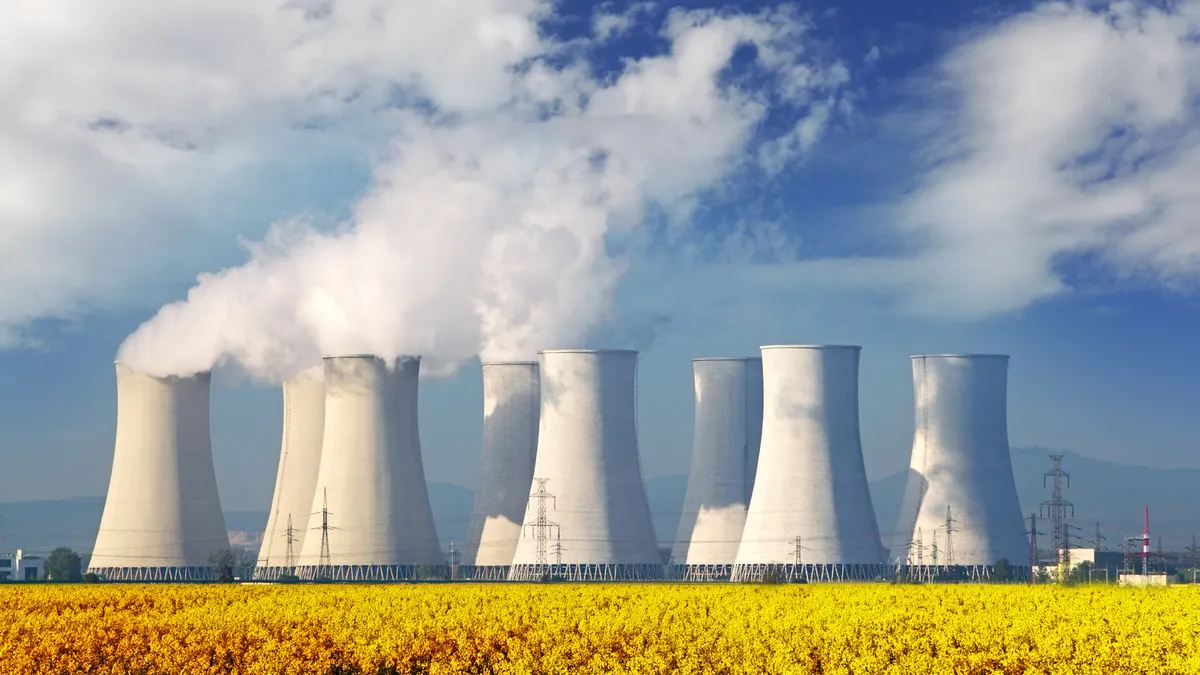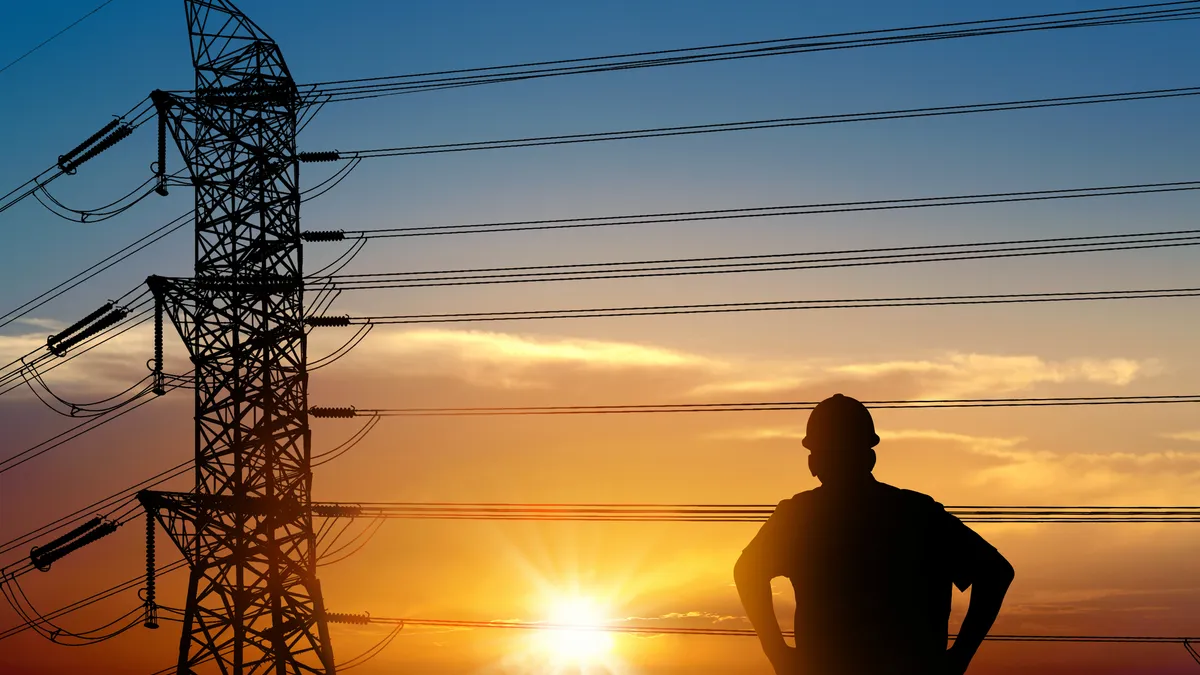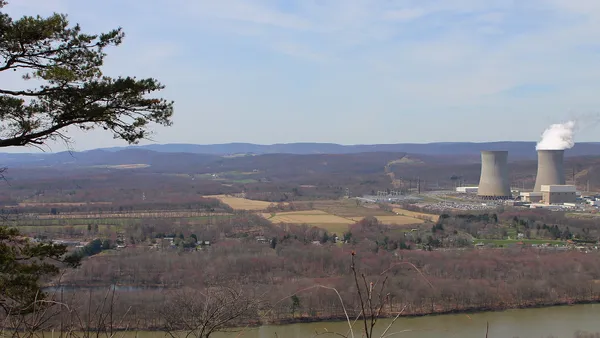As the threat of climate change pushes energy politics center stage, one resource — nuclear — tugs at two priorities: reliability and zero carbon emissions. And bipartisan consensus is growing around the idea that the resource is necessary for a carbon free future.
"Looking at the long term, mid-century de-carbonization strategies, scenario after scenario that many organizations have come out with, from think tanks, from oil companies, they all show a role for nuclear power," Doug Vine, a senior energy fellow at the Center for Energy and Climate Solutions, told Utility Dive.
But the only way nuclear can become competitive against cheaper resources like natural gas and renewables is through policy intervention. And the success of state- and federal-level policy depends in part on framing, according to advocacy group Nuclear Energy Institute.
"From a policymaking perspective, I've noticed it's really hard to focus on more than one dimension at a time," Matt Crozat, senior director of policy development at the Nuclear Energy Institute (NEI), told Utility Dive.
"If all you're thinking about is the climate game, [nuclear looks] a lot like wind, solar. If all you're thinking about is the fuel security angle [nuclear looks] a lot like coal. And so, depending on who you are and what your policy priorities are, how you put [resources] together is the function of what angle you're coming from," he said.
And as the rhetoric plays out, nuclear advocates say federal legislation is still critical to moving the market forward, as flat load and poor economics stymies nuclear investments.
Coupling coal and nuclear
Parallels between coal and nuclear were not really drawn out by energy circles before the Trump administration proposed a coal and nuclear bailout last June, according to policy watchers.
The drafted bailout "was the only time I can recall any direct policy trying to put [coal and nuclear] in the same bucket," said Crozat. Before joining NEI, Crozat spent almost a decade at the Department of Energy.
While the plan is currently on hold, the administration is encouraging state-led action — in March, a Pennsylvania lawmaker told Utility Dive the state crafted a nuclear subsidy bill after DOE staff told him not to wait for federal action. Now, Ohio's House Bill 6 is stirring up more controversy over the idea of providing financial support for nuclear plants and highlights a key policy divide on the resource.
"Where we're seeing [nuclear] bills be successful in the other states, it has generally been as part of a broader coalition that has renewables."

Matt Crozat
Senior Director of Policy Development, Nuclear Energy Institute
Along with providing $150 million annually in subsidies to First Energy Solutions' Davis-Besse and Perry nuclear plants, the Senate version of bill, originally introduced by the House, would freeze the state's renewable energy standard at 8.5% by the end of 2026. HB 6 would also charge some customers a monthly fee to keep afloat two of Ohio Valley Electric Corporation's coal plants.
That perspective is more consistent with the federal narrative around nuclear, which sees the fuel as advantageous because of its baseload structure, similar to coal's.
The two "are kind of tied together from a certain political perspective more than from a technical one in the sense that they tend to be large, baseload generating station, so they're big," Crozat said. "They run a lot of the time. They employ lots of people. They are built in places that aren't cities usually, so they're more rural and, I think, a big part of local economies, and they produce an awful lot of electricity."
Other policy groups that largely support nuclear, have expressed concerns over the bill, despite seeing nuclear as an important component to a carbon-free electric sector.
"I think why New Jersey, New York and Illinois worked is they're bipartisan solutions. They got a broad coalition of people together and had a lot of interests represented."

Doug Vine
Senior Energy Fellow, Center for Energy and Climate Solutions
"Losing carbon-free nuclear power is never a good thing from a climate perspective," Policy Advisor for Third Way's Clean Energy Program Jackie Kempfer told Utility Dive in an email. "But by tying nuclear support to attacks on renewables mandates and extending the life of some of the dirtiest coal plants, HB6 could be even more damaging to climate efforts.”
More broadly, however, Ohio is "an outlier" when it comes to state nuclear policy, said Crozat.
"Where we're seeing [nuclear] bills be successful in the other states, it has generally been as part of a broader coalition that has renewables," he said.
Leaving the door open for nuclear
Pennsylvania "didn't quite get their act together in time for Three Mile Island [to avoid], but I think that they're still kind of trying to work on something there and Ohio is trying to do something similar, or [is] in that same vein," said Vine. "But I think why [the nuclear support policies for] New Jersey, New York and Illinois worked is they're bipartisan solutions. They got a broad coalition of people together and had a lot of interests represented."
"Whatever we can do to kind of extend the lifetime of existing nuclear plants, we should definitely do that. Do I see a lot of new nuclear in North America? No, long term because it's just not price competitive enough with other resources."

Jan Vrins
Managing Director of Energy, Navigant
Overall, nuclear power makes up approximately 55% of the country's zero carbon emissions, according to the Nuclear Energy Institute.
While New York, Illinois and New Jersey have specific policies in place to reward nuclear plants for their carbon-free generation, a wave of 100% clean energy policy in states like Washington, New Mexico and Nevada has focused on a different route: Not incentivizing nuclear outright, but leaving the door open for non-renewable carbon-free technologies, like nuclear, to play a role.
"I think, in all of these [carbon free policies], that you're seeing, 'Okay, look, I might not have a climate policy now, but if this is where we think we're going to wind up, I don't want to lose my nuclear plants before I make the call,'" said Crozat. "It'd be incredibly stupid to close my largest source of carbon free electricity and then decide I'm going to go to carbon free policy.'"
And utilities are taking a similar focus. Some, such as Public Service Co. of New Mexico and Avista, are following the lead of state policymakers to make carbon-free commitments.
Xcel Energy CEO Ben Fowke, who spearheads one of the most aggressive clean energy goals in the country, has said moving away from nuclear power would be "a step back" and has pushed for technology neutral federal funding, focused on research and development for carbon-free, dispatchable resources, such as advanced nuclear reactors.
But without funding and policy at the state and federal levels for small nuclear, the market simply won't get there on its own, say industry watchers.
"We're not seeing a lot of private investments [or] funding going into that space at this moment," Jan Vrins, managing director of energy at Navigant, told Utility Dive at the 2019 Edison Electric Institute conference in June. "Whatever we can do to kind of extend the lifetime of existing nuclear plants, we should definitely do that. Do I see a lot of new nuclear in North America? No, long term because it's just not price competitive enough with other resources."
Like others in the space, he said smaller nuclear plants could play a role "in theory," but unless there is more investment both federally and from industry itself, "we don't see it at this moment."
| State | Policy | Year implemented |
|---|---|---|
| Illinois | Establishes a zero emission standard that gives power providers credit for zero emission resources under the state's Power Agency Act. | 2017 |
| New York | Establishes zero emission credits under the state's Clean Energy Standard. | 2016 |
| New Jersey | Establishes zero emission credits for power plants. | 2018 |
| Washington | 100% carbon-free by 2045 mandate, leaves door open for non-renewable, carbon-free sources. | 2019 |
| Nevada | 100% carbon-free by 2050 mandate, leaves door open for non-renewable, carbon-free sources. | 2019 |
| New Mexico | 100% carbon-free by 2045 mandate, leaves door open for non-renewable, carbon-free sources. | 2019 |
| California | 100% carbon-free by 2045 mandate, leaves door open for non-renewable, carbon-free sources. | 2018 |
Policywatchers say the gap between state-led interest in carbon-free power and diminishing economic feasibility for nuclear needs to be met through federal action, and a triad of policies could get the market there, some say.
Bridging the gap to economic feasibility
Though many analysts seem to agree nuclear power is an important part of the U.S. energy mix, bridging the gap between necessity and economic feasibility in an energy economy increasingly dominated by record-breaking natural gas, wind and solar prices, remains a big question.
Before natural gas prices dropped, the utility industry was talking about a "nuclear renaissance" or a revival of the nuclear industry as a key to boosting carbon free capacity in the U.S. But as demand for electricity flattened, the need for sheer mass power diminished, and the idea of building a large, high capacity nuclear plant became less attractive, according to Vine.
"Lots of large utilities had plans to build big nuclear power plants as part of their integrated resource plans," said Vine. "I think one thing that people didn't foresee is that electricity demand" has been flat for a decade, meaning utilities in general are not desperate for mass capacity.
"I'm not pessimistic about what's going to happen in Washington. And I think there will, at some point, be a comprehensive policy. But I think what's going to drive it along are the state actions."

Matt Crozat
Senior Director of Policy Development, Nuclear Energy Institute
That's why federal policy, specifically federal money, is key to fully propelling the industry forward, said Third Way's Kempfer.
"A number of federal policy tools helped stimulate the expansion of wind and solar in the U.S. It's going to take a similar suite of incentives to continuously pull new zero-carbon technologies into the market," she said.
Three bipartisan bills on nuclear have been introduced in the past three legislative sessions the Nuclear Energy Innovation and Modernization Act, the Nuclear Energy Innovations Act of 2017 and the Nuclear Energy Leadership Act — the first two passed in 2017-2018 and the last passed the Senate Committee on Energy and Natural Resources on Tuesday and is advancing to the full Senate.
The pieces are there, said Crozat "but they're not quite coalescing around the same specifics yet. So it takes some time, which is why ... I'm not pessimistic about what's going to happen in Washington. And I think there will, at some point, be a comprehensive policy. But I think what's going to drive it along are the state actions."






















